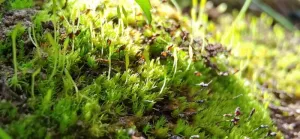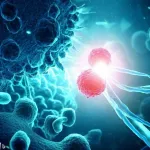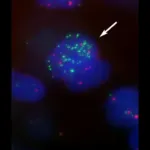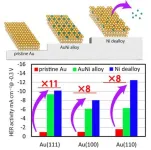The rare moss Takakia has adapted over millions of years to a life at high altitudes. An international research team led by Prof. Dr. Ralf Reski from the University of Freiburg and Prof. Dr. Yikun He from the Capital Normal University / China has now discovered exactly how it has developed the ability to survive frost and life-threatening high UV radiation. In the renowned journal Cell, they describe the genetic traits that protect the moss from extreme environmental conditions. At the same time, they document how climate change greatly altered the natural habitat of this highly specialized species within just a few years.
The genus Takakia comprises only two species. Together, they are found only on the Tibetan Plateau, the “roof of the world”, a hotspot of biodiversity. There, Prof. Dr. Xuedong Li, one of the two first authors of the study, discovered populations of the species Takakia lepidozioides at an altitude of over four thousand metres in 2005. Since then, the team has studied Takakia in the mountains and in the laboratory for more than a decade. For example, the study’s other first author, Dr. Ruoyang Hu, has been on site more than twenty times during the study period. “It is difficult to work at this altitude. High altitude sickness is a problem and sometimes our instruments failed”, Li explains. “Still, I love working in this environment. There you truly understand how important it is to preserve and protect the environment”, Hu says.
On the Tibetan Plateau, Takakia is buried under snow for eight months of the year and otherwise exposed to high levels of UV radiation. To survive there, living creatures need special adaptations. For Takakia, these have evolved over the last 65 million years: Only since then has this region of the Earth been uplifted by continental drift, making the moss's habitat increasingly extreme. “These geological time records help us to trace the gradual adaptation to a life at high altitudes in the Takakia genome”, explains Reski, who conducts research at the University of Freiburg and its Cluster of Excellence CIBSS. In the current study, his team investigated which biological signalling pathways protect the cells of the moss from freezing and mutagenic UV radiation, amongst other things.
Takakia is the oldest living land plant
The moss, which is only a few millimetres in size, is of particular interest to researchers because its systematic affiliation was long unclear, as it combines features of green algae, liverworts and mosses. “We have now been able to prove that Takakia is a moss that separated from the other mosses 390 million years ago, shortly after the emergence of the first land plants. We were surprised to find that Takakia has the highest known number of fast evolving genes under positive selection”, says He.
The living fossil
Another surprise was that the special shape of Takakia could already be found in 165 million-year-old fossils from Inner Mongolia. The fossils thus provide biologists with another valuable time reference because they show that genetic changes affecting morphology evolved more than 165 million years ago under very different environmental conditions. Among these peculiarities is a mode of operation, atypical for plants, of the signalling molecule auxin, which controls growth and development in plants. “Although the Takakia genome is evolving so rapidly, the morphology has not changed recognisably for more than 165 million years. This makes Takakia a true living fossil. This apparent contrast between unchanged shape and rapidly changing genome is a scientific challenge for evolutionary biologists”, Reski describes.
Changing metabolic processes protect against UV radiation
Genetic traits that influence the processing of stress signals and the regulation of certain metabolic processes, on the other hand, are younger, according to the current study, and emerged only after the uplift of the Tibetan Plateau. The researchers were able to reconstruct their gradual emergence within the last 50 million years and show how they protect the cells of the moss from harmful environmental influences. “For example, Takakia regulates its metabolism to accumulate molecules such as flavonoids and unsaturated fatty acids that protect against harmful UV radiation and free radicals”, He explains. “We see in the genome that signalling molecules that regulate DNA repair, photosynthesis and mechanisms against oxidative stress are under particularly strong positive selection and have changed greatly over the last few million years.”
Climate change may put an end to Takakia evolution after 390 million years
While Takakia has had many millions of years to adapt to decreasing temperatures and increasing radiation intensities, its habitat is now changing within decades: Since the measurements began in 2010, the researchers found an average temperature increase of almost half a degree Celsius per year there. At the same time, the glacier near the sample sites receded almost 50 metres per year. The highly specialised moss copes less well with this temperature rise than other species. Takakia populations became significantly smaller over the study period, while other plant species benefited from the warming. This trend is likely to continue, the researchers fear. “Our study shows how valuable Takakia is in tracing the evolution of land plants. The population decline we found is frightening”, He says. “Fortunately, knowing that the plant is threatened by extinction also gives us a chance to protect it, for example by growing it in the lab”, Hu points out. “Takakia has seen the dinosaurs come and go. It has seen us humans coming. Now we can learn something about resilience and extinction from this tiny moss”, Reski concludes.
About the Cluster of Excellence CIBSS
The Cluster of Excellence CIBSS - Centre for Integrative Biological Signalling Studies - aims to gain a comprehensive understanding of biological signalling processes across scales - from the interactions of single molecules and cells to the processes in organs and whole organisms. With the knowledge gained, signals can be controlled in a targeted manner, and this in turn enables researchers not only to gain insights in research, but also to innovate in medicine and plant sciences. www.cibss.uni-freiburg.de
Original publication: Ruoyang Hu, Xuedong Li, Yong Hu, Runjie Zhang, Qiang Lv, Min Zhang, Xianyong Sheng, Feng Zhao, Zhijia Chen, Yuhan Ding, Huan Yuan, Xiaofeng Wu, Shuang Xing, Xiaoyu Yan, Fang Bao, Ping Wan, Lihong Xiao, Xiaoqin Wang, Wei Xiao, Eva L. Decker, Nico van Gessel, Hugues Renault, Gertrud Wiedemann, Nelly A. Horst, Fabian B. Haas, Per K.I. Wilhelmsson, Kristian K. Ullrich, Eva Neumann, Bin Lv, Chengzhi Liang, Huilong Du, Hongwei Lu, Qiang Gao, Zhukuan Cheng, Hanli You, Peiyong Xin, Jinfang Chu, Chien-Hsun Huang, Yang Liu, Shanshan Dong, Liangsheng Zhang, Fei Chen, Lei Deng, Fuzhou Duan, Wenji Zhao, Kai Li, Zhongfeng Li, Xingru Li, Hengjian Cui, Yong E. Zhang, Chuan Ma, Ruiliang Zhu, Yu Jia, Meizhi Wang, Mitsuyasu Hasebe, Jinzhong Fu, Bernard Goffinet, Hong Ma, Stefan A. Rensing, Ralf Reski, Yikun He. Adaptive evolution of the enigmatic Takakia now facing climate change in Tibet. In: Cell 186 (2023). DOI: 10.1016/j.cell.2023.07.003.
Prof. Dr. Ralf Reski is Professor of Plant Biotechnology at the Faculty of Biology at the University of Freiburg and a member of the Clusters of Excellence CIBSS - Centre for Integrative Biological Signalling Studies and livMatS - Living, Adaptive and Energy-Autonomous Materials Systems, as well as of BIOSS - Centre for Biological Signalling Studies. The focus of his research is on the genetics, developmental biology and biotechnological use of mosses. Website: www.plant-biotech.net
Prof. Dr. Yikun He is Professor of Plant Genetics at Capital Normal University, China. His research focuses on the molecular regulatory mechanisms of plant stress response and the exploration of gene resources from plants in extreme environments.
The study was funded by National Natural Science Foundation of China (91631109, 31970658), Science and Technology Department of Tibet Autonomous Region (XZ202301ZY0009N), New Interdisciplinary Construction of Bioinformatics and Statistics of Capital Normal University (2055079), Shenzhen Key Laboratory of South Subtropical Plant Diversity (SSTLAB-2020-02), German Research Foundation DFG (EXC-2189, CIBSS and CRC-Transregio 141, B02) as well as by the Freiburg Institute for Advanced Studies FRIAS and the University of Strasbourg Institute of Advanced Study USIAS (METABEVO). END






